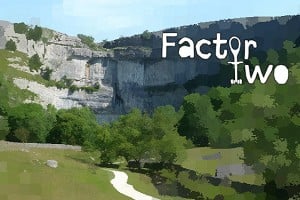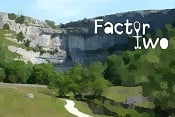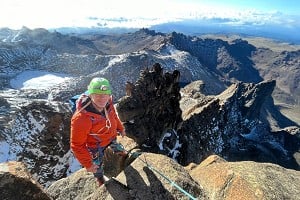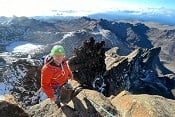
This topic has been archived, and won't accept reply postings.
A physics conundrum for the assorted experts / armchair physicists ...
A couple of weeks ago I climbed Wetherlam from the South one evening. It was a beautiful evening with a clear sky to the East and some clouds bubbling up over Brim Fell from the West. The air was pretty clear, and looking South, to the right of Blackpool Tower and to the left of The Old Man, there was a clear view over the Irish Sea. When I first looked I couldn't make anything out on the horizon, but as the sun set in the West, blocked from view by Brim Fell, and the full moon rose in the East, a range of very distant and yet quite clear pink mountains appeared beyond the sea; 20 minutes later they'd vanished again. It had to be Wales; there's nothing else there -- but I've lived in the lakes for 20 years and I've never seen Wales before from here.
I took a photo, but the mountains are not discernable; however, by comparing the photo to a map back at home, it was clear that bearing was about 210 degrees: smack bang in the middle of Snowdonia 150 km away, with nothing but sea in between. I did some calculation, and although Snowdonia is hidden from view at sea level by the curvature of the earth, you could feasibly make out the tops of the mountains from where I was at 400m.
Anyway, the questions:
Is this a common occurrence?
Why were they only visible during sunset?
How come they weren't visible in my photo?
Would it be the Carneddau?
I have a theory for the second one and a way to test it, but I want to hear what others think.
A couple of weeks ago I climbed Wetherlam from the South one evening. It was a beautiful evening with a clear sky to the East and some clouds bubbling up over Brim Fell from the West. The air was pretty clear, and looking South, to the right of Blackpool Tower and to the left of The Old Man, there was a clear view over the Irish Sea. When I first looked I couldn't make anything out on the horizon, but as the sun set in the West, blocked from view by Brim Fell, and the full moon rose in the East, a range of very distant and yet quite clear pink mountains appeared beyond the sea; 20 minutes later they'd vanished again. It had to be Wales; there's nothing else there -- but I've lived in the lakes for 20 years and I've never seen Wales before from here.
I took a photo, but the mountains are not discernable; however, by comparing the photo to a map back at home, it was clear that bearing was about 210 degrees: smack bang in the middle of Snowdonia 150 km away, with nothing but sea in between. I did some calculation, and although Snowdonia is hidden from view at sea level by the curvature of the earth, you could feasibly make out the tops of the mountains from where I was at 400m.
Anyway, the questions:
Is this a common occurrence?
Why were they only visible during sunset?
How come they weren't visible in my photo?
Would it be the Carneddau?
I have a theory for the second one and a way to test it, but I want to hear what others think.
In reply to crossdressingrodney:
In metric the formula I found is
SquareRoot(height above surface in cms/ 6.752) = distance to horizon in kms.
The height above surface would be your 400m plus the 1000m of Snowdon. Sqr(140000/6.753)=143km.
It could have been clouds or a very strong refracted light causing a mirage due to the temperature.
In metric the formula I found is
SquareRoot(height above surface in cms/ 6.752) = distance to horizon in kms.
The height above surface would be your 400m plus the 1000m of Snowdon. Sqr(140000/6.753)=143km.
It could have been clouds or a very strong refracted light causing a mirage due to the temperature.
Post edited at 22:02
In reply to crossdressingrodney:
I've seen the lakes from Snowdonia, and often the evening, so would say its possible.
I've seen the lakes from Snowdonia, and often the evening, so would say its possible.
In reply to DancingOnRock:
Does that formula gives the distance to the horizon at sea? and does not take account of the height of the object you are looking at.
Using Pythagoras, I get distance to horizon in kms = 3.6 * SQRT(height in metres)
For example, if I stand at the shore, the horizon is ~5 miles away.
But I know that I can see the White Cliffs from the shore at Calais.
I am going to look at Meteors and will do some more trig.
Does that formula gives the distance to the horizon at sea? and does not take account of the height of the object you are looking at.
Using Pythagoras, I get distance to horizon in kms = 3.6 * SQRT(height in metres)
For example, if I stand at the shore, the horizon is ~5 miles away.
But I know that I can see the White Cliffs from the shore at Calais.
I am going to look at Meteors and will do some more trig.
In reply to crossdressingrodney:
Depends how high you are. At 400m you'd just see the top of 1000m mountain 140km away. Another 100m up and you'd see more/further.
Depends how high you are. At 400m you'd just see the top of 1000m mountain 140km away. Another 100m up and you'd see more/further.
In reply to crossdressingrodney:
Perhaps not the mountains but clouds above them, they would be localised to the snowdonia area. The pink is the sunset reflecting of the clouds. You only saw them at sunset because that was when the angle of the light and the contrast was optimum. They'd also explain the ability to see them from so far, as they are higher than the mountains.
The reason they didn't come out on the photo is that your eyes have a higher contrast range than your camera.
Perhaps not the mountains but clouds above them, they would be localised to the snowdonia area. The pink is the sunset reflecting of the clouds. You only saw them at sunset because that was when the angle of the light and the contrast was optimum. They'd also explain the ability to see them from so far, as they are higher than the mountains.
The reason they didn't come out on the photo is that your eyes have a higher contrast range than your camera.
1
In reply to crossdressingrodney:
I saw Blackpool Tower from Prestatyn yesterday at 5 pm from sea level, all of it too, not just the top.
On other occasions I've seen the snow covered Carnedds from Scafell in the day in autumn/winter/spring.
The physics of you seeing wales in the sunset is called Boyonism. Boyon was an 18th century physicist who worked on the theory that at sunset everything, including the atmosphere, became clearer, assuming that the rain had gone.
I saw Blackpool Tower from Prestatyn yesterday at 5 pm from sea level, all of it too, not just the top.
On other occasions I've seen the snow covered Carnedds from Scafell in the day in autumn/winter/spring.
The physics of you seeing wales in the sunset is called Boyonism. Boyon was an 18th century physicist who worked on the theory that at sunset everything, including the atmosphere, became clearer, assuming that the rain had gone.
1
In reply to lowersharpnose:
Yes. Missed the cms.
For the heights I think you can just add the two together. The cliffs at Dover are 100m from memory. That gives 38km.
Yes. Missed the cms.
For the heights I think you can just add the two together. The cliffs at Dover are 100m from memory. That gives 38km.
In reply to crossdressingrodney:
There are your clues.
If the sun is hitting the peaks from 270ish, the sunset light/hues would only illuminate the Western slopes. Since you were watching down on the Eastern slopes at about 30 degrees they would not be pink if they were mountains.
I go for clouds, which would explain why they weren't there 20 minutes later...
> but as the sun set in the West
> a range of very distant and yet quite clear pink mountains
> bearing was about 210 degrees
> a range of very distant and yet quite clear pink mountains
> bearing was about 210 degrees
There are your clues.
If the sun is hitting the peaks from 270ish, the sunset light/hues would only illuminate the Western slopes. Since you were watching down on the Eastern slopes at about 30 degrees they would not be pink if they were mountains.
I go for clouds, which would explain why they weren't there 20 minutes later...
Post edited at 22:46
In reply to DancingOnRock:
You can't just add the height of the object to the height of the observer in the equation. Rather you need to do them both individually and add the results. This is because one will give you the furthest point of sea surface visible from the observation point and the other gives you the furthest point from there you would see a target at the given height.
Adding the results individually gives a total of over 198km.
edit: More specifically, according to your equation, standing at 400m altitude you can see the sea surface 77km away. That leaves a further 73km to your subject, and by inverting the formula you can determine that a person 360m up your subject mountain would also just be visible along the same tangent. That means that any land above 360m on your viewed peaks could have been visible, which still leaves plenty.
You can't just add the height of the object to the height of the observer in the equation. Rather you need to do them both individually and add the results. This is because one will give you the furthest point of sea surface visible from the observation point and the other gives you the furthest point from there you would see a target at the given height.
Adding the results individually gives a total of over 198km.
edit: More specifically, according to your equation, standing at 400m altitude you can see the sea surface 77km away. That leaves a further 73km to your subject, and by inverting the formula you can determine that a person 360m up your subject mountain would also just be visible along the same tangent. That means that any land above 360m on your viewed peaks could have been visible, which still leaves plenty.
Post edited at 23:10
5
In reply to crossdressingrodney:
There are going be refractive effects at play.Maybe these are at their most extreme as sun sets on the observer and the observed(?) I wouldn't have thought that these would have been enough to shift the horizon enough for what you describe though. From memory (and I can't be bothered to look it up or work it out right now) I think the maximum difference you can get in distance to the vanishing point is around 5%
There are going be refractive effects at play.Maybe these are at their most extreme as sun sets on the observer and the observed(?) I wouldn't have thought that these would have been enough to shift the horizon enough for what you describe though. From memory (and I can't be bothered to look it up or work it out right now) I think the maximum difference you can get in distance to the vanishing point is around 5%
In reply to crossdressingrodney:
If you scroll down there's a photo here purportedly of Carnedd Llewelyn from the Old Man of Coniston.
http://www.stridingedge.net/old/Walks/2011/01.%20January/20.01.11.htm
If you scroll down there's a photo here purportedly of Carnedd Llewelyn from the Old Man of Coniston.
http://www.stridingedge.net/old/Walks/2011/01.%20January/20.01.11.htm
2
In reply to crossdressingrodney:
Was on Anglezarke Moors late afternoon on Sunday at 300 metres, and could easily make out Snowdonia, the Ormes and Anglesey. As the crow flies, I was only slightly nearer than you, so my bet is that you were seeing the actual mountains, as per Boyonism mentioned above.
Reckon its more common that we think, but you need to get great visibility matched with nothing blocking your view (i.e. another mountain) to see such long distances.
Was on Anglezarke Moors late afternoon on Sunday at 300 metres, and could easily make out Snowdonia, the Ormes and Anglesey. As the crow flies, I was only slightly nearer than you, so my bet is that you were seeing the actual mountains, as per Boyonism mentioned above.
Reckon its more common that we think, but you need to get great visibility matched with nothing blocking your view (i.e. another mountain) to see such long distances.
In reply to Mike Peacock:
Mike, I think that's the outline I saw (the Arenigs were blocked from view). There was no cloud though, so I could see further down the slope.
Mike, I think that's the outline I saw (the Arenigs were blocked from view). There was no cloud though, so I could see further down the slope.
1
In reply to Philip:
Philip, they really looked like peaks, although I suppose that some isolated clouds could have been clinging to them and looking quite peak-shaped.
What does this mean? Is contrast to do with distinguishing between different colours?
Philip, they really looked like peaks, although I suppose that some isolated clouds could have been clinging to them and looking quite peak-shaped.
> The reason they didn't come out on the photo is that your eyes have a higher contrast range than your camera.
What does this mean? Is contrast to do with distinguishing between different colours?
Post edited at 11:54
In reply to Dave the Rave:
Interesting, thanks.
I know from Feymann's lectures that there is a refraction effect at sunset, and the sun has actually already dropped below the horizon a little while before.
I guess a similar thing would happen here, since the line of sight goes from mountain top to sea level and back to mountain top; the change of pressure would result in a refraction effect, effectively letting you see a little further around the earth's surface than a straight line would allow.
Interesting, thanks.
I know from Feymann's lectures that there is a refraction effect at sunset, and the sun has actually already dropped below the horizon a little while before.
I guess a similar thing would happen here, since the line of sight goes from mountain top to sea level and back to mountain top; the change of pressure would result in a refraction effect, effectively letting you see a little further around the earth's surface than a straight line would allow.
In reply to Mr Lopez:
Good point, hadn't thought of that. This might throw a spanner in the works.
If the sun sets at 20 (?) degrees South of West, that still leaves 40 degrees of aspect (from 300 to 340) that is both illumiated by the sunset and visible from where I was though?
Maybe. I thought maybe the appearing/disappearing acts might be to do with the fact that at sunset, the light is red (hence pink mountains). Red light is scattered least, so still carries an image over a large distance; when other colours are present there is a much more scattered light present, which "washes out" the image.
> If the sun is hitting the peaks from 270ish, the sunset light/hues would only illuminate the Western slopes. Since you were watching down on the Eastern slopes at about 30 degrees they would not be pink if they were mountains.
Good point, hadn't thought of that. This might throw a spanner in the works.
If the sun sets at 20 (?) degrees South of West, that still leaves 40 degrees of aspect (from 300 to 340) that is both illumiated by the sunset and visible from where I was though?
> I go for clouds, which would explain why they weren't there 20 minutes later...
Maybe. I thought maybe the appearing/disappearing acts might be to do with the fact that at sunset, the light is red (hence pink mountains). Red light is scattered least, so still carries an image over a large distance; when other colours are present there is a much more scattered light present, which "washes out" the image.
In reply to crossdressingrodney:
Have a read of this thread on Walk Highlands; http://www.walkhighlands.co.uk/Forum/viewtopic.php?f=1&t=54794
Perfectly possible. This is useful too; http://www.viewfinderpanoramas.org/panoramas/CUM/Coniston-South.gif
Clearer air in the evening is common. I've clearly seen both North Wales and Scotland from Scafell.
Have a read of this thread on Walk Highlands; http://www.walkhighlands.co.uk/Forum/viewtopic.php?f=1&t=54794
Perfectly possible. This is useful too; http://www.viewfinderpanoramas.org/panoramas/CUM/Coniston-South.gif
Clearer air in the evening is common. I've clearly seen both North Wales and Scotland from Scafell.
1
In reply to crossdressingrodney:
If it's any use, I saw the Cuillin Ridge from Stob Coire Sgreamhach in Glen Coe. It was all visible and even individual peaks were easily seen, even on a photograph I took. That's 100km straight line, so I'm sure that at 150km (assuming you were high enough to avoid the curvature/horizon effect, which I don't know) then you'd still be able to distinguish mountains.
If it's any use, I saw the Cuillin Ridge from Stob Coire Sgreamhach in Glen Coe. It was all visible and even individual peaks were easily seen, even on a photograph I took. That's 100km straight line, so I'm sure that at 150km (assuming you were high enough to avoid the curvature/horizon effect, which I don't know) then you'd still be able to distinguish mountains.
In reply to Mal Grey:
Wasn't there a story in one of the historical sections of a guidebook that Craig yr Ysfa was first "discovered" by Owen Glynne Jones or the Abraham Brothers or one of those pioneers while studying the Welsh hills from the top of a lakeland peak?
While I have also seen a blurry outline of the Lakes from Snowdonia quite a few times, I think that story has been exaggerated a few times over the years..........
Wasn't there a story in one of the historical sections of a guidebook that Craig yr Ysfa was first "discovered" by Owen Glynne Jones or the Abraham Brothers or one of those pioneers while studying the Welsh hills from the top of a lakeland peak?
While I have also seen a blurry outline of the Lakes from Snowdonia quite a few times, I think that story has been exaggerated a few times over the years..........
1
In reply to crossdressingrodney:
According to http://www.udeuschle.selfhost.pro/panoramas/makepanoramas_en.htm
there is a clear line of sight to the Carneddau from an altitude of 400m around Kitty Crag above the Coppermines Valley.
150km visibility is not especially rare (I have seen Snowdonia from Bowfell on a clear winter day), so I think it is pretty likely that you did see the Carneddau. There are credible reports of 200km views in the UK (e.g. Ben Macdui to the Cheviot), though none of the longest theoretical sightline (232km, Merrick to Snowdon).
According to http://www.udeuschle.selfhost.pro/panoramas/makepanoramas_en.htm
there is a clear line of sight to the Carneddau from an altitude of 400m around Kitty Crag above the Coppermines Valley.
150km visibility is not especially rare (I have seen Snowdonia from Bowfell on a clear winter day), so I think it is pretty likely that you did see the Carneddau. There are credible reports of 200km views in the UK (e.g. Ben Macdui to the Cheviot), though none of the longest theoretical sightline (232km, Merrick to Snowdon).
In reply to DancingOnRock:
Not sure. Cheviot from Macdui is tricky with the naked eye, as not much of the Cheviot is visible. Mournes from Lakes at ~190km should be no problem though.
> Is that 200km with the naked eye?
Not sure. Cheviot from Macdui is tricky with the naked eye, as not much of the Cheviot is visible. Mournes from Lakes at ~190km should be no problem though.
In reply to Mark Bull:
I once saw the Cairngorms (unsure which bit - maybe Ben y Ghlo?) from Hedgehope Hill in the Cheviots, on a cold still winter day.
On the formula for intervisibility: I make it x = sqrt(y1*R) + sqrt(y2*R) where x is intervisibility distance, y1 and y2 are heights of mountains, and R is Earth's radius (6371 km acc Wikipedia). That's based on tangent to a circle and small-angle trig approximations. It would give 130 km for the max intervisibility from 400 m up Wetherlam to a height of 1000 m.
I once saw the Cairngorms (unsure which bit - maybe Ben y Ghlo?) from Hedgehope Hill in the Cheviots, on a cold still winter day.
On the formula for intervisibility: I make it x = sqrt(y1*R) + sqrt(y2*R) where x is intervisibility distance, y1 and y2 are heights of mountains, and R is Earth's radius (6371 km acc Wikipedia). That's based on tangent to a circle and small-angle trig approximations. It would give 130 km for the max intervisibility from 400 m up Wetherlam to a height of 1000 m.
In reply to rif:
That formula doesn't look right and also gives a result that doesn't tally with observations.
If R is the earth's radius, y is the height above sea level and x is the furthest point of sea surface visible from y, by pythagoras we get:
(R+y)^2 = R^2 + x^2
so x = sqrt(y^2 +2Ry)
With your figure for R this gives 71km range for 400m height and 112km range for 1000m height, so 183km total. Not sure why this is a little lower than the earlier formula but it's in the same ballpark.
That formula doesn't look right and also gives a result that doesn't tally with observations.
If R is the earth's radius, y is the height above sea level and x is the furthest point of sea surface visible from y, by pythagoras we get:
(R+y)^2 = R^2 + x^2
so x = sqrt(y^2 +2Ry)
With your figure for R this gives 71km range for 400m height and 112km range for 1000m height, so 183km total. Not sure why this is a little lower than the earlier formula but it's in the same ballpark.
In reply to john arran:
You're right, I mislaid a "2" somewhere. Formula for horizon distance is x = sqrt(2Ry) when y << R, so my numerical results were too low.
You're right, I mislaid a "2" somewhere. Formula for horizon distance is x = sqrt(2Ry) when y << R, so my numerical results were too low.
In reply to crossdressingrodney:
somebody on woman's hour claimed Wales was visible from a bothy in N. Syke!
i'm with Philip/Lopez..
somebody on woman's hour claimed Wales was visible from a bothy in N. Syke!
i'm with Philip/Lopez..
In reply to crossdressingrodney:
re. dynamic range of eye vs camera:
http://photo.stackexchange.com/questions/21579/how-does-the-dynamic-range-o...
http://petapixel.com/2011/05/05/biology-for-photographers-why-is-the-apertu...
some math: https://en.wikipedia.org/wiki/Weber%E2%80%93Fechner_law
re. dynamic range of eye vs camera:
http://photo.stackexchange.com/questions/21579/how-does-the-dynamic-range-o...
http://petapixel.com/2011/05/05/biology-for-photographers-why-is-the-apertu...
some math: https://en.wikipedia.org/wiki/Weber%E2%80%93Fechner_law
In reply to crossdressingrodney:
On a winter day of superb visibility, we saw both the Wicklow Hills, Lakes, IoM and Galloway Hills from Snowdon.
On a winter day of superb visibility, we saw both the Wicklow Hills, Lakes, IoM and Galloway Hills from Snowdon.
In reply to crossdressingrodney:
Speaking of which - anyone else seen Coniston fells on a clear day from the the Keighley Road a few miles out of Hebden Bridge? Your window of opportunity is small!
Speaking of which - anyone else seen Coniston fells on a clear day from the the Keighley Road a few miles out of Hebden Bridge? Your window of opportunity is small!
In reply to Sean Kelly:
Galloway from Snowdon is a very long one - the most prominent summit is Cairnsmore of Fleet at 213 km.
> On a winter day of superb visibility, we saw both the Wicklow Hills, Lakes, IoM and Galloway Hills from Snowdon.
Galloway from Snowdon is a very long one - the most prominent summit is Cairnsmore of Fleet at 213 km.
In reply to crossdressingrodney:
There's also the phenomenon of the atmosphere being clearer when there is a lot of moisture in the air but not so much that it's raining or misty. Wouldn't the air above that temperature inversion be in that condition i.e. moist but not carrying so much moisture that it diffuses or refracts the light, thus contributing to optimum visual conditions for seeing the distance?
I have done the calculation many times when out walking (distance in miles = square root of 1.5 x height in feet cos I'm still on old money) to determine whether I really was seeing the thing I thought I was seeing, and it does work by combining the result of the cal from where you are with the result of the reverse calc from the other object.
There's also the phenomenon of the atmosphere being clearer when there is a lot of moisture in the air but not so much that it's raining or misty. Wouldn't the air above that temperature inversion be in that condition i.e. moist but not carrying so much moisture that it diffuses or refracts the light, thus contributing to optimum visual conditions for seeing the distance?
I have done the calculation many times when out walking (distance in miles = square root of 1.5 x height in feet cos I'm still on old money) to determine whether I really was seeing the thing I thought I was seeing, and it does work by combining the result of the cal from where you are with the result of the reverse calc from the other object.
This topic has been archived, and won't accept reply postings.
Loading Notifications...








